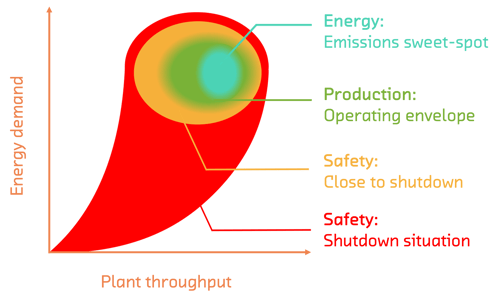
Operating complex process sites involves a constant strive to balance efficiency versus emissions, without compromising safety. The practical approach of reduction of Greenhouse Gas emissions (GHG) start with related to operating energy efficient as the initial measure. The next step often includes fuel switching, combined heat and power, and the use of renewable energy. Reducing the flaring is always a key objective to reduce emissions.
One key objective is to find sources with contradictive energy use. One example is an industrial toaster in a hotel in let´s say Italy. The toaster uses 2,5KW and runs constantly, at least during breakfast or brunch, while at the same time the hotel must add cooling capacity to keep the restaurant from overheating. What’s the toaster in your plant?
Many upstream oil & gas production units also might have a chemical injection process installed. This is either for injection to the upstream oil & gas flow to improve separation, reduce foaming, and reduce corrosion issues at the plant process. Or for injection to downstream, improving the production capacity from the reservoir. The optimal usage of these process packages will improve the emission footprint related to the processes, as well as the chemical product consumptions.
Our Control Room Assistant is based on modelling the objectives of each sub-system of a plant and will identify causal modes and consequences based on plant state. The relative importance will most often be:

The Control Room Assistant will be able to identify consequences and objectives under threat, and immediately suggest mitigations to reduce emissions.
It is important to understand that our qualitative physics approach will assist the control operator in the control rom making everyday decisions. This is not finetuning parameters to reach an optimum sweet spot between emissions and energy consumptions. It is our objective to ensure that clear and easy to understand guidance is given to the operator raising the awareness about the environmental consequences of each decision in real time. The fine tuning of setpoints will typically be a back-office exercise that still has value. One example could a typical plant where the use of one compressor would be sufficient, but two compressors are used to have one running in idle just in case it will be needed. A typical operational decision which might be correct, but environmental impact should at least be known and a part of the decision.
The same modelling toolbox (MFM) is used when building the reduced emissions digital twin. Environmental impact will be clearly communicated to the control room operator with associated mitigation plans. Knowledge and learnings from incidents with environmental impact will be presented to the operator with advice on how to operate - immediately available based on real sensor values.
Since the early days of operating complex hazardous processing plants, there has been a clear focus on building a culture for safety. When making decisions during operation, safe operation is now a clear priority. Adding the GHG emissions will bring more complexity into the decision process. How can we make sure that safety is the first priority and at the same time maintain a high awareness of GHG reductions?
The control room assistant has a user interface that ensures that the focus will be to keep the process safe and whenever production is within the safe operation limits, GHG reduction starts.
The user interface has been developed in close cooperation with both experienced and new control room operators and facilitates this combined safety and GHG emissions reduction. The graphical user interface has been optimized to run on a large screen in the control room and give an instant overview without further user interaction.
We use a radar screen display where closeness to the inner circle indicates the importance of the issue at stake. If the plant is close to safety limits, the mode shifts, and the inner circle becomes yellow. Green inner ring indicates that the focus should be on GHG emissions.
We have included a typical example of a developing scenario below. Initially the operator should have attention on the injection compressor recycle valve and the electric coalescer power consumption to reduce GHG as we are safe within operating condition. As the produced water filter resistance increases this develops into a safety critical situation and needs attention.
Kairos Technology is a software company that develops innovative and disruptive technology within the energy industry.
Phone: +47 952 91 478
E-mail: info(a)kairostech.no
Address Norway:
Kanalsletta 4, N-4033 Stavanger
Address Denmark:
DTU Science Park, Diplomvej 381, DK-2800 Lyngby